Celebrate World Migratory Bird Day (WMBD) with us in our virtual “Birds Connect Our World” edition! Have fun learning about a new migratory bird every day. We have colouring pages, puzzles, activities, and more. Download for free and enjoy nature with your family at home. 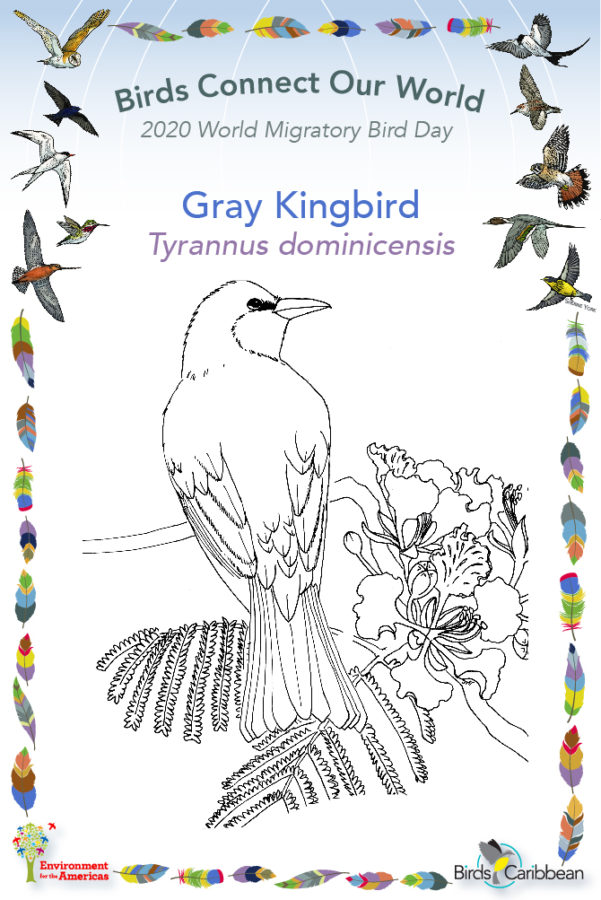
Migratory Bird of the Day: Gray Kingbird
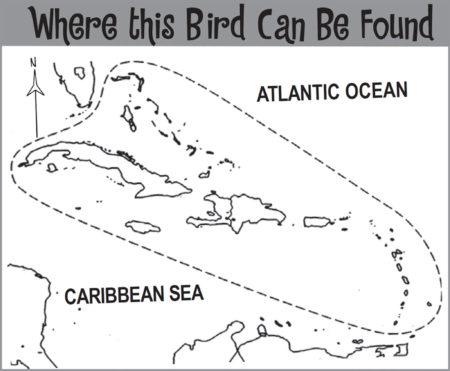 The Gray Kingbird is a large conspicuous species of tyrant flycatcher, a large family of birds known as energetic insectivores. It is gray above and white below and has a dark mask—a distinctive, but faint, black band extending from the base of the beak through the eye. It also has a large black beak with a slight hook at the tip, typical of this group of birds. This species is fiercely territorial during the breeding season and can often be seen chasing and fighting other individuals, employing amazing acrobatic manoeuvres in aerial dogfights. They are also known to chase and attack other birds, dogs, and humans who get too close to their nest. In The Bahamas, this species is locally called “Fighter” or “Pickereely” based on its aggressive behavior and the call it makes. Gray Kingbirds are present year-round in some islands (Hispaniola and islands east), but in others (e.g., Bahamas, Cuba and Jamaica) they arrive in April, breed, and leave in September, and are hence known as “summer migrants.” Their range extends from Florida, the Caribbean, parts of Central America and northern South America. They prefer open habitats and can be seen in abundance in urban and suburban areas. Gray Kingbirds are also found in pinelands, coastal areas and mangroves. Birds that migrate have longer wings, shorter tails and larger bills than those that are resident. Gray Kingbirds feed mainly on various flying insects, including beetles, bees, moths, wasps, and dragonflies. They also eat fruits, seeds, and small vertebrates, like lizards. They may rarely eat hummingbirds, perhaps mistaking them for large insects, killing them by repeated blows on a branch before swallowing them! In The Bahamas, they have been seen eating poisonwood berries. Gray Kingbirds are often seen conspicuously perched, making their loud buzzy calls, pi-tirr-ri or pit-cherrie, repeated often. They sally out from these high perches to grab food items in mid-air. Learn more about this species, including its range, photos, and calls here.
The Gray Kingbird is a large conspicuous species of tyrant flycatcher, a large family of birds known as energetic insectivores. It is gray above and white below and has a dark mask—a distinctive, but faint, black band extending from the base of the beak through the eye. It also has a large black beak with a slight hook at the tip, typical of this group of birds. This species is fiercely territorial during the breeding season and can often be seen chasing and fighting other individuals, employing amazing acrobatic manoeuvres in aerial dogfights. They are also known to chase and attack other birds, dogs, and humans who get too close to their nest. In The Bahamas, this species is locally called “Fighter” or “Pickereely” based on its aggressive behavior and the call it makes. Gray Kingbirds are present year-round in some islands (Hispaniola and islands east), but in others (e.g., Bahamas, Cuba and Jamaica) they arrive in April, breed, and leave in September, and are hence known as “summer migrants.” Their range extends from Florida, the Caribbean, parts of Central America and northern South America. They prefer open habitats and can be seen in abundance in urban and suburban areas. Gray Kingbirds are also found in pinelands, coastal areas and mangroves. Birds that migrate have longer wings, shorter tails and larger bills than those that are resident. Gray Kingbirds feed mainly on various flying insects, including beetles, bees, moths, wasps, and dragonflies. They also eat fruits, seeds, and small vertebrates, like lizards. They may rarely eat hummingbirds, perhaps mistaking them for large insects, killing them by repeated blows on a branch before swallowing them! In The Bahamas, they have been seen eating poisonwood berries. Gray Kingbirds are often seen conspicuously perched, making their loud buzzy calls, pi-tirr-ri or pit-cherrie, repeated often. They sally out from these high perches to grab food items in mid-air. Learn more about this species, including its range, photos, and calls here.
Colour in the Gray Kingbird!
Download the page from Migratory Birds of the West Indies Colouring Book. Use the photos below as your guide, or you can look up pictures of the bird online or in a bird field guide if you have one. Share your coloured-in page with us by posting it online and tagging us @BirdsCaribbean #WMBD2020Carib
Listen to the call of the Gray Kingbird
The call of the Gray Kingbird is a loud high-pitched “pipiri pipiri” trill.
Puzzle of the Day
Click on the images below to do the puzzles. You can make the puzzle as easy or as hard as you like – for example, 6, 8, or 12 pieces for young children, all the way up to 1,024 pieces for those that are up for a challenge!
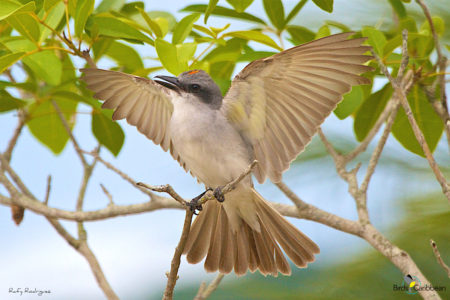
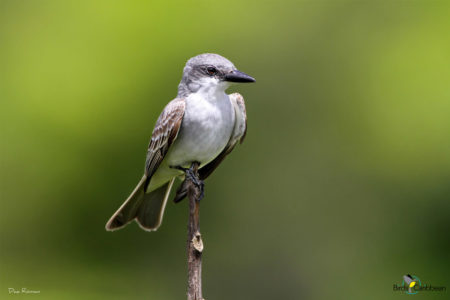
Activity of the Day
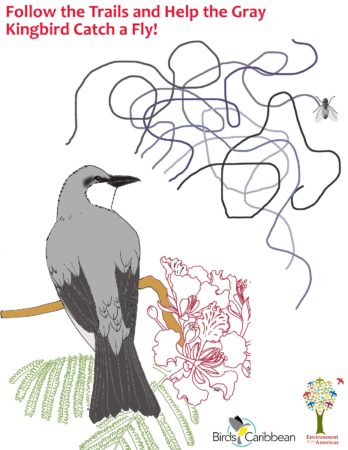 FOR KIDS: Gray Kingbirds often fly out from their perch to snatch insects from the air, with their beak, to eat. Can up help the hungry Gray Kingbird to catch a fly? Follow the right trail and get a tasty fly for the Kingbird to eat! And here is the Answer Key. FOR KIDS AND ADULTS:
FOR KIDS: Gray Kingbirds often fly out from their perch to snatch insects from the air, with their beak, to eat. Can up help the hungry Gray Kingbird to catch a fly? Follow the right trail and get a tasty fly for the Kingbird to eat! And here is the Answer Key. FOR KIDS AND ADULTS:
- Take a walk and see if you can spot a Gray Kingbird or any of our other migratory birds. Use a bird field guide or the FREE Merlin bird ID app to help you identify the birds you are seeing.
- Enjoy the videos below of Gray Kingbirds in the wild! The first shows a bird preening, you can also hear it making its high-pitched trilling call in this clip. The second shows a Gray Kingbird eating an insect it has just caught and then cleaning its beak.
- Visit MigratoryBirdDay.org for many more free activities and resources to learn about migratory birds, their threats and conservation actions you can take.
